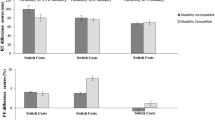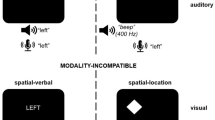Abstract
Recent evidence suggests that the degree of interference in dual-task situations depends crucially on the pairings of input- and output modalities of the two component tasks with increased dual-task costs for modality incompatible (i.e., visual–vocal and auditory–manual) compared to modality compatible (i.e., visual–manual and auditory–vocal) dual tasks. These effects of modality pairings in dual tasks have been related to the overlap of non-preferred processing pathways in modality incompatible tasks. Until now, modality compatibility has not yet been related to other sources of interference in a dual-task context, such as stimulus–response (S–R) compatibility or crosstalk. In the present study, we conducted two experiments using the paradigm of the psychological refractory period (PRP) to test the effects of S–R compatibility and crosstalk on the effects of modality compatibility in temporally overlapping task situations. Experiment 1 revealed an overadditive interaction between stimulus onset asynchrony and modality compatibility for tasks with S–R compatible mappings, indicating that modality compatibility effects are present in different task situations, even when S–R mappings are otherwise compatible. In Experiment 2, we aimed at pinpointing the boundaries of the effects of modality compatibility in dual-task situations. We showed that additional sources of dual-task interference in a modality compatible dual task could overwrite the pronounced PRP effect previously shown for modality incompatible tasks. Taken together, these data provide new evidence that the specific types of stimulus–response modality pairings are an additional factor that might interact with other sources of interference in dual-task situations.







Similar content being viewed by others
Notes
Note that the inclusion of the between subject factor stimulus order did not change the pattern of results reported below.
References
Atchley, P., & Dressel, J. (2004). Conversation limits the functional field of view. Human Factors, 46(4), 664–673.
Atchley, P., Dressel, J., Jones, T., Burson, R., & Marshall, D. (2011). Talking and driving: applications of crossmodal action reveal a special role for spatial language. Psychological Research (this issue).
Cohen, A., & Feintuch, U. (2002). The dimensional-action system: a distinct visual system. In W. Prinz & B. Hommel (Eds.), Common mechanisms in perception and action (Vol. 19, pp. 587–608). Oxford: Oxford University Press.
Fuster, J. M. (2000). Executive frontal functions. Experimental Brain Research, 133(1), 66–70.
Greenwald, A. G. (1972). Evidence of both perceptual filtering and response suppression for rejected messages in selective attention. Journal of Experimental Psychology, 94(1), 58–67.
Hazeltine, E., & Ruthruff, E. (2006). Modality pairing effects and the response selection bottleneck. Psychological Research, 70(6), 504–513.
Hazeltine, E., & Wifall, T. (2011). Searching working memory for the source of dual-task costs. Psychological Research (this issue).
Hazeltine, E., Ruthruff, E., & Remington, R. W. (2006). The role of input and output modality pairings in dual-task performance: Evidence for content-dependent central interference. Cognitive Psychology, 52(4), 291–345.
Hazeltine, E., Teague, D., & Ivry, R. B. (2002). Simultaneous dual-task performance reveals parallel response selection after practice. Journal of Experimental Psychology: Human Perception and Performance, 28(3), 527–545.
Hommel, B. (1998). Automatic stimulus–response translation in dual-task performance. Journal of Experimental Psychology: Human Perception and Performance, 24(5), 1368–1384.
Huestegge, L., & Koch, I. (2009). Dual-task crosstalk between saccades and manual responses. Journal of Experimental Psychology: Human Perception and Performance, 35(2), 352–362.
Huestegge, L., & Koch, I. (2010). Crossmodal action selection: evidence from dual-task compatibility. Memory & Cognition, 38(4), 493–501.
Israel, M., & Cohen, A. (2011). Involuntary strategy-dependent dual task performance. Psychological Research (this issue).
Kornblum, S., Hasbroucq, T., & Osman, A. (1990). Dimensional overlap: Cognitive basis for stimulus–response compatibility. A model and taxonomy. Psychological Review, 97(2), 253–270.
Lien, M. C., & Proctor, R. W. (2002). Stimulus–response compatibility and psychological refractory period effects: implications for response selection. Psychonomic Bulletin & Review, 9(2), 212–238.
Logan, G. D., & Gordon, R. D. (2001). Executive control of visual attention in dual-task situations. Psychological Review, 108(2), 393–434.
Logan, G. D., & Schulkind, M. D. (2000). Parallel memory retrieval in dual-task situations: I. Semantic memory. Journal of experimental psychology. Human perception and performance, 26(3), 1072–1090.
Meyer, D. E., & Kieras, D. E. (1997). A computational theory of executive cognitive processes and multiple-task performance: I. Basic mechanisms. Psychological Review, 104(1), 3–65.
Miller, E. K., & Cohen, J. D. (2001). An integrative theory of prefrontal cortex function. Annual Review of Neuroscience, 24, 167–202.
Pashler, H. (1994). Dual-task interference in simple tasks: data and theory. Psychological Bulletin, 116(2), 220–244.
Ruthruff, E., Hazeltine, E., & Remington, R. W. (2006). What causes residual dual-task interference after practice? Psychological Research, 70(6), 494–503.
Schubert, T. (1999). Processing differences between simple and choice reactions affect bottleneck localization in overlapping tasks. Journal of Experimental Psychology: Human Perception and Performance, 25, 408–425.
Schubert, T., Fischer, R., & Stelzel, C. (2008). Response activation in overlapping tasks and the response-selection bottleneck. Journal of Experimental Psychology: Human Perception and Performance, 34(2), 376–397.
Schubert, T., & Szameitat, A. J. (2003). Functional neuroanatomy of interference in overlapping dual tasks: An fMRI study. Cognitive Brain Research, 17(3), 733–746.
Schuch, S., & Koch, I. (2004). The costs of changing the representation of action: response repetition and response-response compatibility in dual tasks. Journal of Experimental Psychology: Human Perception and Performance, 30(3), 566–582.
Schumacher, E. H., Seymour, T. L., Glass, J. M., Fencsik, D. E., Lauber, E. J., Kieras, D. E., et al. (2001). Virtually perfect time sharing in dual-task performance: uncorking the central cognitive bottleneck. Psychology Science, 12(2), 101–108.
Schumacher, E. H., Schwarb, H., Lightman, E., & Hazeltine, E. (2011). Investigating the modality specificity of response selection using a temporal flanker task. Psychological Research (this issue).
Sigman, M., & Dehaene, S. (2006). Dynamics of the central bottleneck: dual-task and task uncertainty. PLoS Biology, 4(7), e220.
Stelzel, C., Schumacher, E. H., Schubert, T., & D’Esposito, M. (2006). The neural effect of stimulus–response modality compatibility on dual-task performance: an fMRI study. Psychological Research, 70(6), 514–525.
Stephan, D. N., & Koch, I. (2010). Central cross-talk in task switching: Evidence from manipulating input–output modality compatibility. Journal of Experimental Psychology. Learning, Memory, and Cognition, 36(4), 1075–1081.
Stephan, D. N., & Koch, I. (2011). The role of input-output modality compatibility in task switching. Psychological Research (this issue).
Virzi, R., & Egeth, H. (1985). Toward a translational model of Stroop interference. Memory & Cognition, 13(4), 304–319.
Welford, A. (1952). The ‘psychological refractory period’ and the timing of high-speed performance: a review and a theory. British Journal of Psychology, 43, 2–9.
Wickens, C. D. (1980). The structure of attentional resources. In R. S. Nickerson (Ed.), Attention & performance VIII (pp. 239–257). Hillsdale: Erlbaum.
Wickens, C., Sandry, D., & Vidulich, M. (1983). Compatibility and resource competition between modalities of input, central processing, and output. Human Factors: The Journal of the Human Factors and Ergonomics Society, 25(2), 227–248.
Wylie, G., Sumowski, J. F., & Murray, M. (2011). Are there control processes, and (if so) can they be studied? Psychological Research (this issue).
Author information
Authors and Affiliations
Corresponding author
Electronic supplementary material
Below is the link to the electronic supplementary material.
Rights and permissions
About this article
Cite this article
Stelzel, C., Schubert, T. Interference effects of stimulus–response modality pairings in dual tasks and their robustness. Psychological Research 75, 476–490 (2011). https://doi.org/10.1007/s00426-011-0368-x
Received:
Accepted:
Published:
Issue Date:
DOI: https://doi.org/10.1007/s00426-011-0368-x




